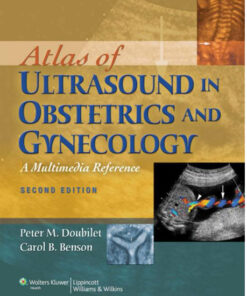OBSTETRICS & GYNECOLOGY IMAGING
OBSTETRICS & GYNECOLOGY IMAGING
Atlas of Ultrasound in Obstetrics and Gynecology: A Multimedia Reference Second Edition
OBSTETRICS & GYNECOLOGY IMAGING
Gynecologic Ultrasound: A Problem-Based Approach, 1e Edition
OBSTETRICS & GYNECOLOGY IMAGING
Donald School: Atlas of Clinical Application of Ultrasound in Obstetrics and Gynecology 1/E Edition
OBSTETRICS & GYNECOLOGY IMAGING
Donald School Textbook of Ultrasound in Obstetrics & Gynecology 1st Edition
OBSTETRICS & GYNECOLOGY IMAGING
Hysteroscopy: Office Evaluation and Management of the Uterine Cavity: Text 1e
OBSTETRICS & GYNECOLOGY IMAGING
Ecografía en obstetricia y ginecología, 5e (Spanish Edition) (Spanish) 5th Edition
GENERAL GYNECOLOGY
Introduction
Obstetrics and gynecology imaging is a powerful tool for diagnosing and treating a variety of conditions related to women’s health. This guide provides an overview of the different types of imaging available, as well as the benefits they can provide to patients. From ultrasounds to MRI scans, this guide will help you understand the advantages of each type of imaging and how it can help you get the best care possible. With the right information, you can unlock the full potential of obstetrics and gynecology imaging and ensure that you receive the best treatment available.
Understanding the Benefits of OB/GYN Imaging
Obstetrics and gynecology (OB/GYN) imaging is a specialized form of medical imaging used to diagnose and treat conditions related to the female reproductive system. It is an important tool for diagnosing and treating a variety of conditions, including infertility, endometriosis, pelvic inflammatory disease, ovarian cysts, uterine fibroids, and more. OB/GYN imaging can also be used to monitor pregnancies and detect any potential problems.
OB/GYN imaging uses a variety of imaging techniques to create detailed images of the female reproductive organs. These techniques include ultrasound, magnetic resonance imaging (MRI), computed tomography (CT) scans, and X-rays. Ultrasound is the most commonly used technique in OB/GYN imaging, as it is non-invasive and provides clear images of the uterus, ovaries, and other reproductive organs. MRI and CT scans are also used to provide detailed images of the reproductive organs, but they require the patient to be exposed to radiation. X-rays are used less often, as they do not provide as much detail as other imaging techniques.
The benefits of OB/GYN imaging are numerous. It can help diagnose and treat a variety of conditions, including infertility, endometriosis, pelvic inflammatory disease, ovarian cysts, and uterine fibroids. It can also be used to monitor pregnancies and detect any potential problems. Additionally, OB/GYN imaging can be used to evaluate the effectiveness of treatments and medications.
OB/GYN imaging is a safe and effective way to diagnose and treat conditions related to the female reproductive system. It is non-invasive and provides detailed images of the reproductive organs, allowing doctors to accurately diagnose and treat a variety of conditions. Additionally, OB/GYN imaging can be used to monitor pregnancies and detect any potential problems. For these reasons, OB/GYN imaging is an invaluable tool for diagnosing and treating conditions related to the female reproductive system.
Exploring the Different Types of OB/GYN Imaging Tests
OB/GYN imaging tests are an important part of diagnosing and treating a variety of conditions related to the female reproductive system. These tests can help detect abnormalities, diagnose diseases, and monitor the progress of treatments. OB/GYN imaging tests include ultrasound, MRI, CT scans, X-rays, and mammograms. Each type of test has its own advantages and disadvantages, so it is important to understand the differences between them in order to make an informed decision about which test is best for you.
Ultrasound is one of the most common types of OB/GYN imaging tests. It uses sound waves to create images of the inside of the body. Ultrasound is used to evaluate the size and shape of the uterus, ovaries, and other organs in the pelvic area. It can also be used to detect cysts, fibroids, and other growths. Ultrasound is noninvasive and does not use radiation, making it a safe option for pregnant women.
MRI (magnetic resonance imaging) is another type of imaging test that is often used in OB/GYN. It uses magnetic fields and radio waves to create detailed images of the body. MRI is especially useful for detecting tumors, cysts, and other abnormalities in the reproductive organs. It is also used to monitor the progress of treatments such as chemotherapy or radiation therapy.
CT scans (computed tomography) are another type of imaging test that is used in OB/GYN. CT scans use X-rays to create cross-sectional images of the body. They are often used to diagnose ovarian cysts, uterine fibroids, and other conditions. CT scans are more detailed than ultrasounds, but they do use radiation, so they should be used with caution in pregnant women.
X-rays are another type of imaging test that is used in OB/GYN. X-rays use radiation to create images of the body. They are often used to diagnose fractures, dislocations, and other injuries. X-rays are not typically used to diagnose conditions in the reproductive organs, but they can be used to detect certain types of cancer.
Mammograms are a type of imaging test that is used to detect breast cancer. Mammograms use X-rays to create images of the breasts. They are recommended for all women over the age of 40, and they can help detect breast cancer in its early stages.
OB/GYN imaging tests are an important part of diagnosing and treating conditions related to the female reproductive system. It is important to understand the differences between the different types of tests in order to make an informed decision about which test is best for you.
Preparing for an OB/GYN Imaging Test
Preparing for an OB/GYN imaging test can be a daunting task, but it is important to understand the process and what to expect. An OB/GYN imaging test is used to diagnose and monitor conditions related to the female reproductive system. It is important to discuss any concerns or questions you may have with your doctor prior to the test.
Before the test, you will need to provide your medical history and any medications you are taking. You should also inform your doctor of any allergies or sensitivities you may have. Depending on the type of imaging test, you may need to fast for several hours before the procedure. Your doctor will provide specific instructions regarding fasting and other preparations.
On the day of the test, you should wear comfortable clothing that does not contain metal. You may also be asked to remove jewelry and other items that could interfere with the imaging equipment. During the test, you may be asked to change positions or hold your breath for short periods of time. This helps ensure that the images are clear and accurate.
After the test, you may experience some discomfort or soreness in the area where the imaging was done. This is normal and should subside within a few days. Your doctor will review the results of the imaging test and discuss any further treatment or follow-up care that may be necessary.
By understanding the process and preparing properly, you can help ensure that your OB/GYN imaging test is successful. If you have any questions or concerns, be sure to speak with your doctor prior to the test.
Interpreting the Results of an OB/GYN Imaging Test
Interpreting the results of an OB/GYN imaging test is a critical part of diagnosing and treating gynecological conditions. Imaging tests such as ultrasound, MRI, CT scans, and X-rays can provide valuable information about the health of a woman’s reproductive organs. By interpreting the results of these tests, doctors can determine the best course of treatment for their patients.
When interpreting the results of an OB/GYN imaging test, doctors look for any abnormalities in the size, shape, or structure of the reproductive organs. They also look for any signs of infection or inflammation. In addition, they may check for any masses or cysts that could indicate a more serious condition.
Ultrasound is one of the most common imaging tests used in OB/GYN. It uses sound waves to create images of the uterus, ovaries, and other reproductive organs. Ultrasound can detect abnormalities in the size, shape, and structure of the reproductive organs. It can also detect any masses or cysts that may be present.
MRI is another imaging test used in OB/GYN. It uses magnetic fields and radio waves to create detailed images of the reproductive organs. MRI can detect any abnormalities in the size, shape, and structure of the reproductive organs. It can also detect any masses or cysts that may be present.
CT scans are also used in OB/GYN. They use X-rays to create detailed images of the reproductive organs. CT scans can detect any abnormalities in the size, shape, and structure of the reproductive organs. They can also detect any masses or cysts that may be present.
X-rays are the least commonly used imaging test in OB/GYN. They use radiation to create images of the reproductive organs. X-rays can detect any abnormalities in the size, shape, and structure of the reproductive organs. They can also detect any masses or cysts that may be present.
By interpreting the results of an OB/GYN imaging test, doctors can diagnose and treat gynecological conditions. This helps ensure that women receive the best possible care for their reproductive health.
Knowing When to Seek Further Medical Advice After an OB/GYN Imaging Test
When it comes to OB/GYN imaging tests, it is important to know when to seek further medical advice. Imaging tests such as ultrasounds, CT scans, and MRIs are used to diagnose a variety of conditions related to the reproductive system. While these tests can provide valuable information, they may not always be able to provide a definitive diagnosis. In some cases, further testing or consultation with a specialist may be necessary.
If your doctor has recommended an imaging test, it is important to understand what the results mean and when you should seek further medical advice. If the results of the imaging test are inconclusive or if there are any abnormalities present, your doctor may recommend additional testing or a referral to a specialist. It is important to follow your doctor’s instructions and seek further medical advice if recommended.
In addition to following your doctor’s instructions, it is also important to pay attention to any changes in your body or symptoms that may indicate a problem. If you experience any new or worsening symptoms, such as pain, bleeding, or discharge, it is important to contact your doctor right away. Your doctor may recommend additional testing or a referral to a specialist.
It is also important to keep track of any changes in your menstrual cycle. If you notice any changes in your cycle, such as irregular periods or missed periods, it is important to contact your doctor. Your doctor may recommend additional testing or a referral to a specialist.
Finally, it is important to be aware of any family history of reproductive health issues. If you have a family history of reproductive health issues, it is important to discuss this with your doctor. Your doctor may recommend additional testing or a referral to a specialist.
Knowing when to seek further medical advice after an OB/GYN imaging test is important for ensuring that any potential problems are identified and treated promptly. If you have any questions or concerns about your imaging test results, it is important to contact your doctor right away.
Conclusion
Unlocking the Benefits of OBSTETRICS & GYNECOLOGY IMAGING: A Guide for Patients is an invaluable resource for women seeking to understand the imaging technologies used in obstetrics and gynecology. This guide provides a comprehensive overview of the various imaging techniques, their benefits, and potential risks. It also offers practical advice on how to prepare for an imaging procedure and what to expect during and after the exam. With this information, patients can make informed decisions about their care and feel more confident in their healthcare choices.








